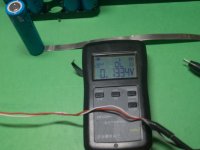I probably should post this in the battery section, but maybe something discussed here in the past...when it comes to voltage sag for a given pack, how much sag, if any, can be attributed to poor pack construction (other components used for constructing the pack, etc.) versus cell choice? This is assuming the cells are all tested and matched. For example, two pack builders use the same quality cells, but the components they use (nickel/copper strips, etc.) or construction technique (spot weld, solder, bolt together holders, etc.), is there a difference in the voltage sag under load?
I guess a few follow up questions, if there is a significant difference, are, is it safe to assume that voltage sag due to construction of the pack when near LVC isn't actually harming the cells, when they are above LVC, so I'd only be concerned with the additional heat from the underated strips? Can a pack be retrofitted easily to remove the bottlenecks from poor construction?
I guess a few follow up questions, if there is a significant difference, are, is it safe to assume that voltage sag due to construction of the pack when near LVC isn't actually harming the cells, when they are above LVC, so I'd only be concerned with the additional heat from the underated strips? Can a pack be retrofitted easily to remove the bottlenecks from poor construction?



